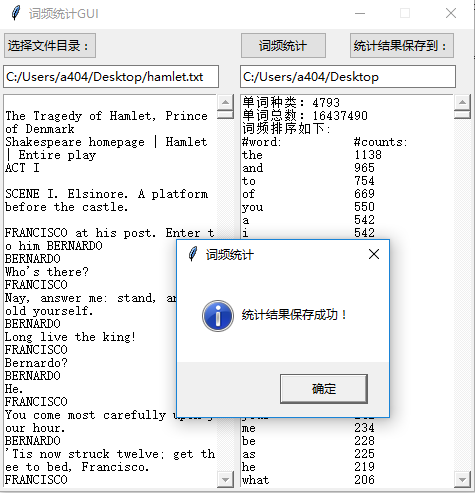字典是针对非序列集合而提供的一种数据类型,字典中的数据是无序排列的。
字典的操作
为字典增加一项
dict[key] = value
students = {"Z004":"John","T002":"Peter"}
students
Out[23]: {'T002': 'Peter', 'Z004': 'John'}
students["S007"] = "Susan"
students
Out[25]: {'S007': 'Susan', 'T002': 'Peter', 'Z004': 'John'}访问字典中的值
dict[key] 返回key对应的值value
dict.get(key,default)--返回字典中key对应的值,若未找到key,则返回default值,default值可不写
删除字典中的一项
del dict[key]
字典的遍历
遍历字典的键key
for key in dict.keys():print(key)
遍历字典的值value
for value in dict.values():print(value)
遍历字典的项
for item in dict.items():print(item)
是否一个键在字典中
注:值不能判断
in 或者 not in
删除字典项目
dict.clear()--删除字典中的所有项目
dict.pop(key)--删除并返回字典中key对应的值
直接赋值、浅拷贝、深拷贝
直接赋值:其实就是对象的引用(别名)。
浅拷贝(copy):拷贝父对象,不会拷贝对象的内部的子对象。
深拷贝(deepcopy): copy 模块的 deepcopy 方法,完全拷贝了父对象及其子对象。
字典浅拷贝实例:
>>>a = {1: [1,2,3]}
>>> b = a.copy()
>>> a, b
({1: [1, 2, 3]}, {1: [1, 2, 3]})
>>> a[1].append(4)
>>> a, b
({1: [1, 2, 3, 4]}, {1: [1, 2, 3, 4]})>>>import copy
>>> c = copy.deepcopy(a)
>>> a, c
({1: [1, 2, 3, 4]}, {1: [1, 2, 3, 4]})
>>> a[1].append(5)
>>> a, c
({1: [1, 2, 3, 4, 5]}, {1: [1, 2, 3, 4]})示例:词频统计
第一步:输入文章
第二步:建立用于词频计算的空字典
第三步:对文本的每一行计算词频,如果文章长度一般,则不需用一次读一行,一次便可读完。
第四步:从字典中获取数据对到列表中
第五步:对列表中的数据对交换位置,并从大到小进行排序
第六步:输出结果
下图所示为程序输出结果及输出的统计结果

汉字的词频统计、排除特定词集合的程序后续更新...
普通版本
def getText():
txt=open('hamlet.txt','r').read()
txt=txt.lower()
for ch in "~@#$%^&*()_-+=<>?/,.:;{}[]|\'""":
txt=txt.replace(ch,' ')
return txt
hamletTxt=getText()
words=hamletTxt.split()
counts={}
sumcount = 0
for word in words:
counts[word]=counts.get(word,0)+1
sumcount = sumcount + 1
items=list(counts.items())
items.sort(key=lambda x:x[1],reverse=True)
for i in range(10):
word,count=items[i]
print('{0:<10}{1:>5}'.format(word,count))
#将统计结果写入文本文件中
outfile = open('词频统计结果.txt', "w")
lines = []
lines.append('单词种类:'+str(len(items))+'\n')
lines.append('单词总数:'+str(sumcount)+'\n')
lines.append('词频排序如下:\n')
lines.append('word\tcounts\n')
s= ''
for i in range(len(items)):
s = '\t'.join([str(items[i][0]), str(items[i][1])])
s += '\n'
lines.append(s)
print('\n统计完成!\n')
outfile.writelines(lines)
outfile.close()排除特定词库
#排除词库
excludes = ['the','and','to','of','i','a','in','it','that','is',
'you','my','with','not','his','this','but','for',
'me','s','he','be','as','so','him','your']
def getText():
txt=open('hamlet.txt','r').read()
txt=txt.lower()
for ch in "~@#$%^&*()_-+=<>?/,.:;{}[]|\'""":
txt=txt.replace(ch,' ')
return txt
hamletTxt=getText()
words=hamletTxt.split()
counts={}
sumcount = 0
for word in words:
counts[word]=counts.get(word,0)+1
sumcount = sumcount + 1
counts_ex = counts.copy()
for key in counts.keys():
if key in excludes:
counts_ex.pop(key)
items=list(counts_ex.items())
items.sort(key=lambda x:x[1],reverse=True)
for i in range(10):
word,count=items[i]
print('{0:<10}{1:>5}'.format(word,count))
#将统计结果写入文本文件中
outfile = open('词频统计结果.txt', "w")
lines = []
lines.append('单词种类:'+str(len(items))+'\n')
lines.append('单词总数:'+str(sumcount)+'\n')
lines.append('词频排序如下:\n')
lines.append('word\tcounts\n')
s= ''
for i in range(len(items)):
s = '\t'.join([str(items[i][0]), str(items[i][1])])
s += '\n'
lines.append(s)
print('\n统计完成!\n')
outfile.writelines(lines)
outfile.close()GUI版本

import tkinter as tk
from tkinter import ttk
from tkinter import scrolledtext
from tkinter import filedialog
from tkinter import messagebox as mBox
#获取原文内容
def getText(DIR):
txt=open(DIR,'r').read()
return txt
txt.close()
#打开文件
def __opendir():
srcText.delete('1.0', tk.END) # 先删除所有
# 打开文件夹对话框
fname = filedialog.askopenfilename(filetypes=( ("Text file", "*.txt*"),("HTML files", "*.html;*.htm")))
entryvar.set(fname) # 设置变量entryvar,等同于设置部件Entry
if not fname:
mBox.showwarning('警告', message='未选择文件夹!') # 弹出消息提示框
#显示需要统计的文本
Txt=getText(fname)
srcText.insert(tk.END, Txt)
srcText.update()
#手动输入文件名时回车键触发
def srcEnter(event=None):
fname=DirEntry.get()
if not fname:
mBox.showwarning('警告', message='请选择文件!') # 弹出消息提示框
Txt=getText(fname)
srcText.insert(tk.END, Txt)
srcText.update()
#词频统计
def wordFrequence():
fname=DirEntry.get()
if not fname:
mBox.showwarning('警告', message='请选择文件!') # 弹出消息提示框
txt=getText(fname)
#对原文进行小写,标点符号转换处理
txt=txt.lower()
for ch in '!"#$%&*()+,.-;:<=>?@[]\^_{}|`':
txt=txt.replace(ch,' ')
#词频统计
words=txt.split()
counts={} #用空字典存储统计结果
for word in words:
counts[word]=counts.get(word,0)+1
#词频排序
items=list(counts.items())
items.sort(key=lambda x:x[1],reverse=True)
#输出排序结果
num=0
for i in range(len(counts)):
word,count=items[i]
num=i*count+num
dstText.insert(tk.END, '单词种类:')
dstText.insert(tk.END, str(len(items)))
dstText.insert(tk.END, '\n')
dstText.insert(tk.END, '单词总数:')
dstText.insert(tk.END, str(num))
dstText.insert(tk.END, '\n')
dstText.insert(tk.END, '词频排序如下:\n')
dstText.insert(tk.END, '#word:\t\t#counts:\n')
for i in range(len(counts)):
word,count=items[i]
dstText.insert(tk.END, word)
dstText.insert(tk.END, '\t\t')
dstText.insert(tk.END, count)
dstText.insert(tk.END, '\n')
def savefile():
# 打开文件夹对话框
dirname = filedialog.askdirectory()
outvar.set(dirname) # 设置变量entryvar,等同于设置部件Entry
if not dirname:
mBox.showwarning('警告', message='请选择保存位置!') # 弹出消息提示框
fname=dirname+'\词频统计结果.txt'
outfile = open(fname, "w")
outfile.writelines(dstText.get(1.0,tk.END))
outfile.close()
mBox.showinfo('词频统计', '统计结果保存成功!')
def dstEnter(event=None):
dirname=outvar.get()
if not dirname:
mBox.showwarning('警告', message='请选择保存位置!') # 弹出消息提示框
fname=dirname+'\词频统计结果.txt'
outfile = open(fname, "w")
outfile.writelines(dstText.get(1.0,tk.END))
outfile.close()
mBox.showinfo('词频统计', '统计结果保存成功!')
# Create instance
win = tk.Tk()
# Add a title
win.title("词频统计GUI")
# Disable resizing the GUI
win.resizable(0,0)
#---------------窗口控件介绍------------------#
#打开文件对话框
SelDirButton = ttk.Button(win, command=__opendir, text='选择文件目录:')
SelDirButton.grid(row=0, column=0,sticky=tk.W,pady=3,padx=3)
#文件的目录显示
entryvar = tk.StringVar()
DirEntry=ttk.Entry(win, width=30,textvariable=entryvar)
DirEntry.grid(row=1, column=0,sticky=tk.W,pady=3,padx=3)
DirEntry.bind('<Return>', func=srcEnter)
#文件内容的显示
srcText = scrolledtext.ScrolledText(win,width=30,height=30)#内容输出框
srcText.grid(row=2, column=0,columnspan=1,sticky=tk.W,pady=3,padx=3)
#词频统计按钮
CalcuButton = ttk.Button(win, command=wordFrequence, text='词频统计')
CalcuButton.grid(row=0, column=1,sticky=tk.W,pady=3,padx=3)
#统计结果显示
dstText = scrolledtext.ScrolledText(win,width=30,height=30)#内容输出框
dstText.grid(row=2, column=1,columnspan=2,sticky=tk.W,pady=3,padx=3)
#保存文件按钮
SavefileButton = ttk.Button(win, command=savefile, text='统计结果保存到:')
SavefileButton.grid(row=0, column=2,sticky=tk.W,pady=3,padx=3)
#保存文件目录
outvar = tk.StringVar()
saveEntry=ttk.Entry(win, width=30,textvariable=outvar)
saveEntry.grid(row=1, column=1,columnspan=2,sticky=tk.W,pady=3,padx=3)
saveEntry.bind('<Return>', func=dstEnter)
#======================
# Start GUI
#======================
win.mainloop()






















 394
394

 被折叠的 条评论
为什么被折叠?
被折叠的 条评论
为什么被折叠?








